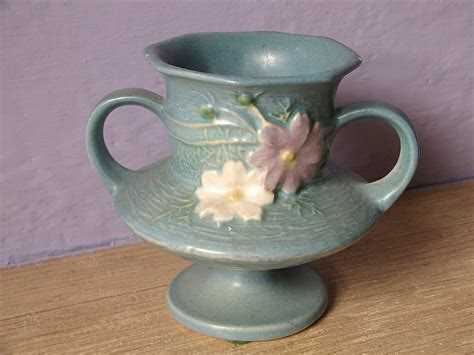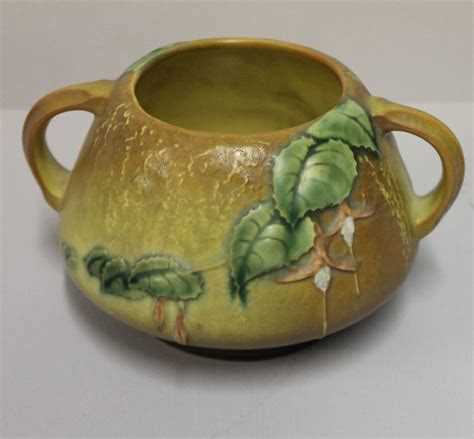Roseville Pottery is a famous brand of ceramics that was produced in the United States from the late 19th century to the mid-20th century. It is known for its distinctive art nouveau and art deco designs, as well as its high-quality craftsmanship. The pottery was highly sought after during its production years, and continues to be highly collectible today.
The history of Roseville Pottery dates back to 1892, when a group of pottery manufacturers in Roseville, Ohio, came together to form the Roseville Pottery Company. The company quickly gained a reputation for producing innovative and beautiful pottery pieces, and became known for its unique glazes and intricate designs. Over the years, the company went through several changes in ownership and location, but it continued to produce highly collectible pottery throughout its history.
One of the most notable features of Roseville Pottery is the variety of designs and patterns that were produced. From the art nouveau-inspired floral designs of the early 20th century to the more streamlined and geometric art deco designs of the 1920s and 1930s, each piece of Roseville Pottery has its own unique style. Some of the most popular patterns include the “Futura” and “Freesia” designs, which are characterized by their bold colors and intricate detailing.
Today, Roseville Pottery is highly sought after by collectors and enthusiasts around the world. The pieces are prized for their beauty, craftsmanship, and historical significance. Whether you are a seasoned collector or just starting out, exploring the history and creations of Roseville Pottery is a fascinating journey that can provide a deeper understanding and appreciation for this iconic brand.
History of Roseville Pottery
Roseville Pottery is a type of ceramic pottery that was produced in Roseville, Ohio from 1890 to 1954. It is known for its high quality and unique designs, making it highly sought after by collectors today.
The history of Roseville Pottery began when a group of businessmen in Ohio decided to start a pottery company. They purchased a small factory in the town of Roseville and began producing stoneware and earthenware pottery. The company quickly gained a reputation for its craftsmanship and attention to detail.
In the early 1900s, Roseville Pottery expanded its product line to include decorative art pottery. The company hired talented artists and designers who created innovative and intricate designs. Some of the most popular designs include the “Freesia” pattern, with its delicate floral motifs, and the “Pinecone” pattern, featuring pinecones and needles.
During the Great Depression, Roseville Pottery faced financial difficulties like many other businesses. However, the company managed to survive by creating more affordable lines of pottery, such as the “Zephyr Lily” and “Snowberry” patterns.
In the 1940s, Roseville Pottery experienced a surge in popularity. The company produced pottery for the war effort and also created lines of pottery for the home. These pieces featured bold and colorful designs, often inspired by nature.
Unfortunately, Roseville Pottery was forced to close its doors in 1954 due to increased competition and changing consumer preferences. However, the legacy of Roseville Pottery lives on through the collectors and enthusiasts who appreciate its beauty and craftsmanship.
Today, Roseville Pottery is highly prized by collectors and can command high prices at auctions and antique stores. The unique designs and high quality craftsmanship continue to captivate collectors who appreciate the artistry and history of this iconic American pottery.
Founders and Creators of Roseville Pottery
Roseville Pottery was founded by George Young and Ross Purdy in Roseville, Ohio in 1890. The company started out as the Roseville Pottery Company and initially focused on producing simple, utilitarian pottery items.
However, it wasn’t until Frederick Rhead, a talented ceramic artist, joined the company in 1904 that Roseville Pottery started to gain recognition for its art pottery. Rhead introduced more innovative designs and artistic elements into the pottery, which set it apart from other companies at the time.
Under Rhead’s creative direction, Roseville Pottery became known for its unique shapes, vibrant glazes, and detailed decorations. The company’s art pottery lines, such as “Futura,” “Rosecraft,” and “Wisteria,” became highly sought-after among collectors and enthusiasts.
In 1910, Rhead left Roseville Pottery to work for other ceramic companies, but his contributions to the company’s artistic legacy and success cannot be overstated.
After Rhead’s departure, the company continued to flourish under the leadership of talented designers and artisans. Some notable individuals who contributed to the success of Roseville Pottery include Frank Ferrell, George Krause, and Harry Warrick.
Ferrell, who joined the company in 1918, played a key role in designing and developing some of Roseville Pottery’s most iconic lines, such as “Pine Cone” and “Freesia.” Krause, another important designer, introduced the popular “Futura” line in the 1920s.
Warrick, who joined Roseville Pottery in 1922, became the company’s art director and was responsible for the introduction of the highly collectible “Donatello” line.
Overall, the founders and creators of Roseville Pottery, along with the talented designers and artisans who joined the company over the years, played a significant role in establishing Roseville Pottery as one of the premier ceramic art pottery manufacturers in the United States.
Early Successes and Influences
Soon after its founding in 1892, Roseville Pottery began to see success and recognition for its unique and beautiful ceramic pieces. The company quickly garnered attention for its innovative designs and mastery of decorative techniques, setting it apart from other pottery manufacturers of the time.
One of the key factors that contributed to Roseville Pottery’s early success was its emphasis on hiring talented and experienced artists. The company recruited skilled craftsmen who had previously worked for other prominent ceramic manufacturers, such as Rookwood Pottery and Weller Pottery. These artists brought their knowledge and expertise to Roseville, helping to shape the company’s distinctive style and high level of craftsmanship.
Another influential factor was the Arts and Crafts movement, which was gaining popularity in the late 19th and early 20th centuries. This artistic movement emphasized craftsmanship and the use of natural materials, rejecting mass-produced goods in favor of handmade and unique pieces. Roseville Pottery embraced the principles of the Arts and Crafts movement, creating pottery that reflected the ideals of the movement through its meticulous craftsmanship and organic designs.
In addition to the Arts and Crafts movement, Roseville Pottery was also influenced by the Art Nouveau style. Art Nouveau, which emerged in the late 19th century, was characterized by its flowing lines, floral motifs, and nature-inspired designs. Roseville Pottery incorporated these elements into many of its pieces, creating a distinctive visual aesthetic that set it apart from other pottery manufacturers.
One of Roseville Pottery’s early successes was the introduction of the Roseville Rozane line. Introduced in 1900, the Rozane line was a series of high-quality, hand-decorated pieces that quickly became popular among collectors and art enthusiasts. The success of the Rozane line helped establish Roseville Pottery as a leading producer of art pottery in the United States.
Overall, Roseville Pottery’s early successes can be attributed to its talented artists, the influence of artistic movements such as the Arts and Crafts movement and Art Nouveau, and the introduction of popular and innovative lines such as the Rozane line. These factors laid the foundation for Roseville Pottery’s continued success and reputation as a premier producer of art pottery.
Innovations and Unique Styles
Roseville Pottery was known for its innovative designs and unique styles that set it apart from other pottery manufacturers of its time. The company was at the forefront of the Arts and Crafts movement, which emphasized the use of natural materials and handmade craftsmanship.
One of the key innovations of Roseville Pottery was the introduction of the “effect matte” glaze. This glaze gave the pottery a soft, velvety texture and a mottled appearance, which was unlike anything else on the market. It was achieved by layering different colored glazes over each other and then firing them at high temperatures.
Another unique feature of Roseville Pottery was its use of intricate and detailed reliefs. Many of their pieces featured raised designs of flowers, leaves, or other natural motifs. These reliefs were achieved by carefully carving the design into a plaster mold, and then pressing it onto the wet clay before it was fired.
Roseville Pottery also experimented with different shapes and forms, creating pieces that were not only beautiful but also functional. They produced vases, bowls, planters, and other decorative items that showcased their artistic vision. Each piece was meticulously crafted by skilled artisans, ensuring both quality and uniqueness.
The company was also known for its extensive line of patterns and patterns, each with its own distinct style. They drew inspiration from a variety of sources, including Art Nouveau, Art Deco, and the natural world. This diversity in design allowed customers to find something that suited their personal taste and aesthetics.
Overall, the innovations and unique styles of Roseville Pottery made it a standout in the pottery world. Their attention to detail, use of innovative glazes, and commitment to craftsmanship set them apart from their competitors and continue to be admired by collectors and enthusiasts today.
Decline and Revival
Despite its early success, Roseville Pottery faced financial challenges in the 1930s due to the Great Depression. The demand for luxury items like pottery declined, forcing the company to reevaluate its production strategies. As a result, Roseville Pottery shifted its focus from art pottery to more utilitarian items such as gardenware and cookie jars.
By the 1950s, competition from other pottery manufacturers and changing consumer preferences further contributed to Roseville Pottery’s decline. The company struggled to adapt to the new market trends and eventually closed its doors in 1954.
For several decades, Roseville Pottery remained relatively forgotten, with its pieces often overlooked or undervalued. However, in the 1970s, there was a revived interest in American art pottery, including Roseville. Collectors and enthusiasts started to appreciate the unique designs and craftsmanship of Roseville Pottery, leading to a resurgence of interest in the brand.
Today, Roseville Pottery is highly sought after by collectors and continues to be admired for its distinctive style and craftsmanship. The pieces are now considered valuable collectibles and can fetch high prices at auctions and antique markets.
Collecting Roseville Pottery
Collecting Roseville Pottery is a popular hobby for antique enthusiasts and art pottery lovers. With its unique designs and rich history, Roseville Pottery has become highly sought after by collectors all over the world. Whether you are a seasoned collector or just starting out, here are some tips to help you on your Roseville Pottery collecting journey:
- Learn the History: Before you start collecting Roseville Pottery, it’s important to familiarize yourself with the history and background of the company. Understanding the different periods, artists, and styles will make it easier to identify and appreciate the pieces you come across.
- Research Prices: As with any collectible, the value of Roseville Pottery can vary greatly depending on factors such as condition, rarity, and desirability. Take the time to research prices and educate yourself on the current market trends. This will help you make informed decisions when it comes to buying and selling.
- Attend Auctions and Estate Sales: Auctions and estate sales are great places to find Roseville Pottery at potentially lower prices. Keep an eye out for local events in your area and be prepared to bid against other collectors. It’s important to have a budget in mind and stick to it to avoid overspending.
- Inspect Carefully: When purchasing Roseville Pottery, always inspect the piece carefully for any damages or repairs. Look for hairline cracks, chips, or any signs of restoration. These factors can significantly affect the value of the piece. If buying online, ask for detailed photos and a condition report before making a final decision.
- Focus on What You Love: Collecting Roseville Pottery should be a reflection of your own personal taste and interest. Focus on collecting pieces that you genuinely love and enjoy. Whether it’s the vibrant colors, intricate patterns, or sleek designs, choose pieces that resonate with you on a deeper level.
- Display and Enjoy: Once you have started your Roseville Pottery collection, display your pieces proudly in your home. Whether it’s a beautiful vase on a mantle or a set of plates showcased in a cabinet, displaying your collection not only allows you to enjoy the beauty of the pieces but also adds a touch of history and art to your space.
Remember, collecting Roseville Pottery is a journey, and it’s important to be patient and take your time to find the perfect pieces for your collection. Happy hunting!
Legacy and Impact
Roseville Pottery had a significant impact on the ceramic industry and left a lasting legacy in the world of American art pottery. The company’s innovative designs and exceptional craftsmanship set a new standard for the industry, elevating pottery from functional objects to works of art.
One of the key legacies of Roseville Pottery is its role in popularizing Art Deco and Art Moderne styles in American ceramics. The company’s designers, such as Frederick Rhead and Frank Ferrell, created bold and dynamic designs that reflected the aesthetic trends of their time. These designs, with their geometric shapes and sleek lines, captured the spirit of the Art Deco movement and became highly sought-after by collectors.
Another significant impact of Roseville Pottery was its role in promoting the art pottery movement in the United States. The company’s commitment to creating unique and artistic pieces inspired other American pottery manufacturers to experiment with innovative designs and techniques. In this way, Roseville Pottery helped to shape the development of the American art pottery industry as a whole.
Today, Roseville Pottery continues to be highly valued and admired by collectors and enthusiasts. The company’s pieces are prized for their beauty, craftsmanship, and historical significance. Roseville Pottery has become synonymous with quality and artistry in the world of American ceramics, and its influence can still be seen in the work of contemporary potters.
| Legacy | Roseville Pottery set a new standard for the ceramic industry, elevating pottery to works of art. |
| Impact | Roseville Pottery popularized Art Deco and Art Moderne styles and inspired the art pottery movement in the US. |
| Continued Value | Roseville Pottery is highly valued by collectors and remains influential in the world of ceramics. |
FAQ:
Who were the makers of Roseville Pottery?
The makers of Roseville Pottery were a group of talented artisans from Roseville, Ohio who worked in the pottery industry during the early 20th century.
When was Roseville Pottery created?
Roseville Pottery was created in 1890 in Roseville, Ohio.
What is the history of Roseville Pottery?
The history of Roseville Pottery dates back to 1890 when a group of pottery experts came together and established the company in Roseville, Ohio. Over the years, it gained recognition for its unique designs and high-quality craftsmanship. However, the company faced several challenges, including the Great Depression, which eventually led to its closure in 1954.
Who were the creators of Roseville Pottery?
The creators of Roseville Pottery were William Lowe, George F. Young, and John F. Young, who were all experienced potters and had a passion for creating beautiful ceramic pieces.
What makes Roseville Pottery special?
Roseville Pottery is special because of its unique and intricate designs, as well as its high-quality craftsmanship. The artisans at Roseville Pottery were known for their attention to detail and their ability to create beautiful and functional ceramic pieces.
Why did Roseville Pottery close?
Roseville Pottery faced several challenges throughout its history, including the Great Depression, which significantly impacted the pottery industry. The company struggled to stay afloat during this time and eventually closed its doors in 1954.
Where can I find Roseville Pottery today?
Today, Roseville Pottery can be found in antique stores, online marketplaces, and at pottery shows and auctions. Collectors and enthusiasts are always on the lookout for these unique and beautiful ceramic pieces.


